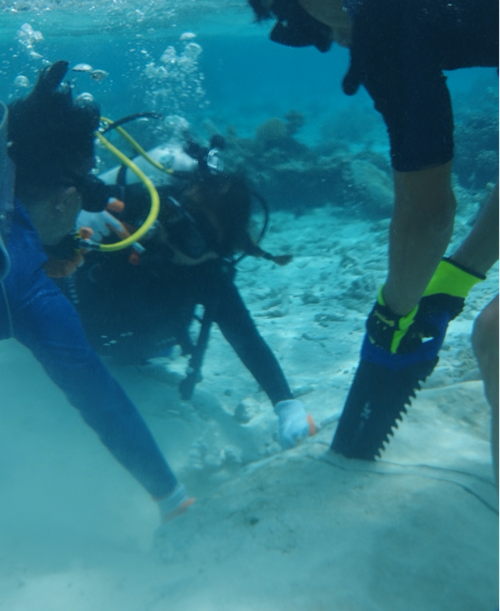The Maldives archipelago is one of the top-rated places in the world for pristine beaches and water sports. But I went there for a totally different reason: a research trip. The archipelago’s geographical location makes it a key research site for climate science. For example, the low-lying and small-size land is extremely vulnerable to the effects of ongoing ocean warming which causes thermal expansion of the water and sea-level rise.
I was part of a team of scientists from the Isotope Geochemistry group at the Earth Observatory of Singapore who travelled to a small island in southern Maldives in February 2023 to study past changes in sea surface temperature (SST). Because none of the instrumental recordings in the region can go back more than one hundred years, we had to use another method to go back further in time. By analysing the chemical composition of fossil corals, we can recover SST history over the past several hundred years and more.

Group photo of team members with Ali, owner of the research facility, on our last day (Source: Lin Ke/Earth Observatory of Singapore)
Over seven days, we sampled a range of fossil corals, including porites - a type of corals which is round and has a hard skeleton. A colony of such corals can form microatolls, which grow vertically initially, then horizontally when they reach the sea surface. These corals can live for hundreds of years, and record both the elevation of the sea surface and the physical and chemical conditions of the ocean water as they were growing. This is because corals use calcium and carbonates from the ocean to grow their skeleton. As a result, sturdy and large microatolls allow us to obtain a long record of climate data.
 Team sampling the dead fossil corals (Source: Wang Jingyu/Earth Observatory of Singapore)
Team sampling the dead fossil corals (Source: Wang Jingyu/Earth Observatory of Singapore)
The density of the corals skeletons depends on the seasonal change in seawater conditions, which include SST, nutrient and sunlight intensity. This variation in density forms growth bands which can be viewed under X-ray. We then count the bands to estimate their ages. But band counting gives a relative age as we do not know exactly when the coral stopped growing. Radiometric dating methods, which use the radioactive decay of some elements such as Uranium, allow to obtain the absolute ages of these corals. And it can do so with a good precision, sometimes with an error as small as one year for young corals.
The next step is to analyse the chemical composition of each band. Previous studies by my team showed that chemical compositions in corals – both oxygen isotopes and trace metals – can precisely estimate the SST history. With the samples collected from this trip, we expect to obtain a SST record for the central tropical Indian Ocean for the past 500 years. This work will help us understand when and how the human-caused warming started affecting the open ocean.
 The first slab of fossil coral, ruptured into three segments (Source: Lin Ke/Earth Observatory of Singapore)
The first slab of fossil coral, ruptured into three segments (Source: Lin Ke/Earth Observatory of Singapore)
Such studies are challenging in Singapore because the ocean temperature here is strongly affected by land masses surrounding the island state and by intensive human activities in the region. Unlike Singapore, our site in the Maldives is isolated from the continents, making it an ideal location to study open ocean SST changes with minimum human-induced disturbances. This study would eventually serve as a point of reference for other climate studies, especially around the Indian Ocean.
Studying corals from the Maldives provides a unique opportunity to gain insight into the SST changes over time, and to understand how the industrial era has affected our ocean. The reconstruction of the SST record will help us better understand the climate system. With this knowledge, we can assess the future warming trend in the tropical Indian Ocean, the impacts on the tropical marine ecosystems and how these ecosystems adapt.
This research is funded by research grants from the Earth Observatory of Singapore and the Ministry of Education, Singapore.